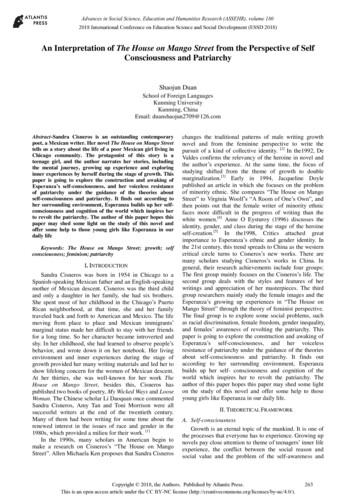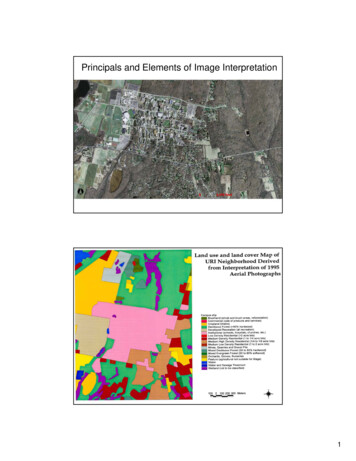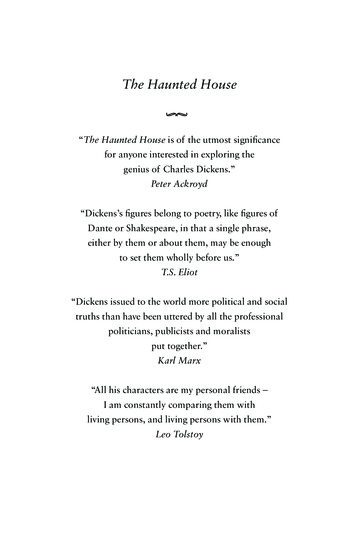
Transcription
Advances in Social Science, Education and Humanities Research (ASSEHR), volume 1802018 International Conference on Education Science and Social Development (ESSD 2018)An Interpretation of The House on Mango Street from the Perspective of SelfConsciousness and PatriarchyShaojun DuanSchool of Foreign LanguagesKunming UniversityKunming, ChinaEmail: duanshaojun2709@126.comAbstract-Sandra Cisneros is an outstanding contemporarypoet, a Mexican writer. Her novel The House on Mango Streettells us a story about the life of a poor Mexican girl living inChicago community. The protagonist of this story is ateenage girl, and the author narrates her stories, includingthe mental journey, growing up experience and exploringinner experiences by herself during the stage of growth. Thispaper is going to explore the construction and awaking ofEsperanza’s self-consciousness, and her voiceless resistanceof patriarchy under the guidance of the theories aboutself-consciousness and patriarchy. It finds out according toher surrounding environment, Esperanza builds up her selfconsciousness and cognition of the world which inspires herto revolt the patriarchy. The author of this paper hopes thispaper may shed some light on the study of this novel andoffer some help to those young girls like Esperanza in ourdaily lifeKeywords: The House on Mango Street; growth; selfconsciousness; feminism; patriarchyI. INTRODUCTIONSandra Cisneros was born in 1954 in Chicago to aSpanish-speaking Mexican father and an English-speakingmother of Mexican descent. Cisneros was the third childand only a daughter in her family, she had six brothers.She spent most of her childhood in the Chicago’s PuertoRican neighborhood, at that time, she and her familytraveled back and forth to American and Mexico. The lifemoving from place to place and Mexican immigrants’marginal status made her difficult to stay with her friendsfor a long time. So her character became introverted andshy. In her childhood, she had learned to observe people’sbehavior, and wrote down it on her notebook. Her livingenvironment and inner experiences during the stage ofgrowth provided her many writing materials and led her toshow lifelong concern for the women of Mexican descent.At her thirties, she was well-known for her work TheHouse on Mango Street, besides this, Cisneros haspublished two books of poetry, My Wicked Ways and LooseWoman. The Chinese scholar Li Daoquan once commentedSandra Cisneros, Amy Tan and Toni Morrison were allsuccessful writers at the end of the twentieth century.Many of them had been writing for some time about therenewed interest in the issues of race and gender in the1980s, which provided a milieu for their work. [1]In the 1990s, many scholars in American begin tomake a research on Cisneros’s “The House on MangoStreet”. Allen Michaela Ken proposes that Sandra Cisneroschanges the traditional patterns of male writing growthnovel and from the feminine perspective to write thepursuit of a kind of collective identity. [2] In the1992, DeValdes confirms the relevancy of the heroine in novel andthe author’s experience. At the same time, the focus ofstudying shifted from the theme of growth to doublemarginalization.[3] Early in 1994, Jacqueline Doylepublished an article in which she focuses on the problemof minority ethnic. She compares “The House on MangoStreet” to Virginia Woolf’s “A Room of One’s Own”, andthen points out that the female writer of minority ethnicfaces more difficult in the progress of writing than thewhite women.[4] Anne O Eysturoy (1996) discusses theidentity, gender, and class during the stage of the heroineself-creation.[5] In the1998, Critics attached greatimportance to Esperanza’s ethnic and gender identity. Inthe 21st century, this trend spreads to China as the westerncritical circle turns to Cisneros’s new works. There aremany scholars studying Cisneros’s works in China. Ingeneral, their research achievements include four groups:The first group mainly focuses on the Cisneros’s life. Thesecond group deals with the styles and features of herwritings and appreciation of her masterpieces. The thirdgroup researchers mainly study the female images and theEsperanza’s growing up experiences in “The House onMango Street” through the theory of feminist perspective.The final group is to explore some social problems, suchas racial discrimination, female freedom, gender inequality,and females’ awareness of revolting the patriarchy. Thispaper is going to explore the construction and awaking ofEsperanza’s self-consciousness, and her voicelessresistance of patriarchy under the guidance of the theoriesabout self-consciousness and patriarchy. It finds outaccording to her surrounding environment, Esperanzabuilds up her self- consciousness and cognition of theworld which inspires her to revolt the patriarchy. Theauthor of this paper hopes this paper may shed some lighton the study of this novel and offer some help to thoseyoung girls like Esperanza in our daily life.II. THEORETICAL FRAMEWORKA. Self-consciousnessGrowth is an eternal topic of the mankind. It is one ofthe processes that everyone has to experience. Growing upnovels pay close attention to theme of teenagers’ inner lifeexperience, the conflict between the social reason andsocial value and the problem of the self-awareness andCopyright 2018, the Authors. Published by Atlantis Press.This is an open access article under the CC BY-NC license 63
Advances in Social Science, Education and Humanities Research (ASSEHR), volume 180construction in teenagers’ growth stage. The Younger’growth is a kind of social transformation, that is to say, theteenagers said goodbye to the carefree childhood, theirself-consciousness was awakened ,and they were eager tobecome mature and independent. In this growth stage, theywere also desire to be understood, possess the friendshipand know the true meaning of life. All of these teenager’sinner experiences were in constant collision processesduring which the youths became ripe, mature from thechildish naivety. In The House on Mango Street, theprotagonist’s growth process is an awakening andconstructive to the self-awareness.B. The Theory of PatriarchyPatriarchal (Patriarchy) means a male as the center ofpower. In English Patriarchy can refer to the patriarchal,patriarchal system and the parents are the rulers in a family.In Chinese we usually don’t distinguish them [1].The feminist theory was used too much in the past time,and it is the American writer Kate Millet who is theearliest writer to introduce the theory of patriarchy intofeminist theory. This concept appears in her masterpiecesexual politics, thus the patriarchy is a new beginningcompared to the feminist theory. She thinks that the root ofwomen suffering oppression is the “patriarchy”, whichputs the female and the male in a completely oppositesituation. The original meaning of “Patriarchy” refers tothe system of social relations of the father as the powerfulcentre, and Millet adds to the new meaning for it: Firstly,the male dominates the female; secondly, the male eldersdominates junior [1]. In the 1960 s, this concept is definedas the systematic system of male superiority and femaleinferiority.III. THE CONSTRUCTION AND AWAKING OF ESPERANZA’SSELF-CONSCIOUSNESSA. The PovertyThe reason why Esperanza’s family moved into theMango Street was that landlord refused to repair thebroken pipes in their formerly house. Before they movedinto the house on Mango Street, she and her family hadmoved for a lot of times. She dreams of a white house witha large space and a lot of bathrooms. However, the houseon Mango Street has only one bedroom and one smallbathroom. When she moved into the house, Esperanzafounds that it is not the house that she envisioned.Although her parents told her it is a short transitionalperiod, she doubted they still need to move into otherplaces in someday. She knows the house on Mango Streetis better than the previous apartment, because her familyowns the house. It’s no longer belonging to the landlords.What’s more, they don’t need to pay rent to the landlords,or be afraid of making too much noise in house, or sharingthe yard with the neighbors, and so on. Though for now,the house has some significant advantages more than herprevious apartments, the house has broken her beautifulfantasy and it is still not the house that Esperanza wants topoint out as hers. Esperanza even admitted that she has akind of sense of shame living there. Her father is a poorgardener, and her mother is a housewife without too mucheducation experience. These observations stimulated herchildish heart. To some extent, these observations and herinner experiences also arouse her thinking of the fates ofMexican women and herself in future, and she wants tohave house all her own.B. Esperanza’s Awareness of Racial DifferencesIn the chapter of “My Name”, Esperanza alwaysmeditates on the meaning of her name. In English hername means “hope,” on the contrary, in Spanish her namemeans “too many letters,” as well as “sadness,” “a muddycolors” and “waiting”, which are all meaningful symbols.Esperanza says that her long name of polysyllable is fromthe Spanish. In the school of America, her classmatesthought Esperanza’s name is weird and funny. As theMexican immigrant she has to face these problemsbetween the ethnic traditional culture and the real world,either to make a compromise with the real world or topursue her dreams. Esperanza understands that she belongsto “brown race”.In the section of Cathy Queen of cats, Kathy is veryfriendly who offered to introduce her local neighborhoodsand shops in the barrio. However, she still has a kind ofsuperiority, and she brags about her French relatives andthe house in France. Though Cathy does not make clearlyracist comments about the Esperanza, she understands thatthe comment relates to her, so Esperanza thinks Cathy isrude. Cathy says that the arrival of nonwhites wouldreduce the grade of the community and her family has tokeep moving further away these families like Esperanza’sfamily. All these words were spoken out from the tongueof a child, which cruelly reflects the contradiction, ills andprejudice of the adult society. The awareness ofEsperanza’s racial differences awakes up suddenly.C. Esperanza’s Awareness of FeminismIn “The House on Mango Street”, Cisneros used manywords to describe the consciousness of Esperanza’sfeminism. Sensitive Esperanza found early that the boysand girls lived in separate world. The boys lived in theiruniverse, and we in ours. She can talk with her brother athome, outside, even her younger brother also refused totalk with her. So Esperanza must socialize with her sisterNanny. In this world, the women often suffered genderdiscrimination.Marian is a young beautiful woman from Puerto Ricowho lives with her cousin’s family. She spends most of hertime to take care of the baby of her cousin’s family, so shecannot leave the house. Marian doesn’t like this kind oflife, she wants to change it. So the only thing she can do is“under the streetlight, dancing by herself” [6]179, waitingfor a man from America who will take her to leave hereand change her life, however, he never came here.Lupe is Esperanza’s aunt with an incurable disease,who had been looking forward to the coming of the god ofthe death, because she was tortured by the sickness, andthe sickness made her can’t perform the responsibility andobligation as a wife and mother. Her children don’t want towash the dishes, and don’t want to iron father’s clothes.Therefore, she feels ashamed and upset when she thoughtabout her husband who wants to marry another woman.264
Advances in Social Science, Education and Humanities Research (ASSEHR), volume 180There is no doubt that her weak body bearing the femalevirtues of docile, loving and self sacrifice. And all of thesefemale virtues are highly praised in patriarchy society.These kinds of old gender discrimination and absurdbehavior methods stimulate Esperanza’s thinking. Shehates this kind of conception. At the same time, theconception of the feminist and independence is taking rootand growing in her heart.D. Esperanza’s Construction of Self-consciousnessAt the beginning of the story, Esperanza just wants topossess house of her own, to get out of poverty, and toleave the Mango Street. Esperanza whispered one of herown poems in Lupe’s ear. Then Lupe told her that sheshould keep writing because it will make her free. Theword freedom catches the eye of Esperanza, but freedomdoes not mean that getting out of the barrio. At first, shedoesn’t understand what the meaning of the sentence thatAlicia says “ like it or not you are from Mango Street, andone day you’ll come back too”[6]276, so Esperanza answersthat she doesn’t want to come here until somebody makesit better. Then Alicia asks who will make it better,suggesting the mayor as the possibility. Esperanzaimmediately understands that she just gets out of thepoverty in Mango Street, not the Mango Street. Eventually,at the end of the novel Esperanza knows that one day shewill leave here with her books and writing materials, butshe will have to leave for the purpose that she would comeback for the people who cannot get out of Mango Street.Esperanza finally realizes that she really wants to changethe life of herself and the people who often suffer theracial discrimination like her, and she loves them, so shewants to help the people of Mexican descendant,especially the Mexican women. Esperanza begins toaccept her position in her community and decides that themost important way she can define herself is as a writer,this is a kind of pursuit of self –value.IV. THE HEROINE’S VOICELESS RESISTANCE OFPATRIARCHYA. Father Being Women’s Direct Oppressor in a FamilyThe Heroine Esperanza in The House on Mango Streetuses her pure eyes to observe the world in her growthprocess. In this process, Esperanza going through her innerexperience and the interaction with the surroundingenvironment and the ethnic group has formed a differentdream from others. She realizes that if she wants tocompletely get rid of the oppression from patriarchy, shehas to wait patiently. In addition, Esperanza makes adetermination to use writing as the method of voicelessresistance to win the respect, and to help those people whocan not come out from the dilemma like her.Father is a specific representative in the patriarchysociety. In a family, father possesses a paramount power,being women’s direct oppressor, and Marin is one of thevictims. Marin on one hand hopes to stay in Chicago onemore year so that she can get a job as the white-collar indowntown. On the other hand, she hopes to meet a richman owning driving car and having a big house who willmarry her and take her to leave the barrio. However, theconcept of the family in the patriarchy forces Marin to stayat home to look after Louie’s sisters. She is located at thebottom in Louie’s family, and enslaved in the society andeconomy, without any power of dominating her owndestiny and family. Under the system, the women belongto the subordinate status, and always was oppressed anddominated by the men, becoming the victims of thepatriarchy. Therefore, only in the evenings, when Marin’suncle and aunt went to sleep, she could temporarily get ridof this kind of bondage; she takes her radio outside anddances under the streetlight, lighting up a cigarette, andwaiting for boys to come here. Her behavior is not just forattracting a man but more for being a kind of abreactionand comfort under the oppression of the patriarchy.B. Women Being Regarded as Men’s AccessoriesIn the patriarchy society, women are regarded as men’saccessories, and the women don’t enjoy the equal rightslike the men. In the Mango Street, the women suffering theoppression of patriarchy can be found in everywhere.Esperanza has the same name with her great-grandmother,“so wild she wouldn’t marry. Until my great-grandfatherthrew a sack over her head and carried her off. Just likethat, as if she were a fancy chandelier. That’s the way hedid it” [6]160. Then she never forgives him, and spendsher life looking out the window and longing for escape.Great-grandmother chooses the resentment which is themethod of voiceless resistance to win the respect, and tofight against the fate.History sometimes can replay during the longdeveloping process of human beings. Like Espranza’sgreat-grandmother, Rafaela is also one of the womenspending their lives looking out of the window andlonging for escape. Rafaela is so beautiful that her husbandoften locks her in their third-floor apartment, because he’safraid she’ll escape. This is a kind of ruthless deprival ofthe freedom of women, reflecting the female’s inferiorposition in a family. On Tuesdays, she spends theseafternoons and evenings leaning out of the window, whichmakes her prematurely old. In her deep heart she wants togo to the bar down the street to have a dance while she isstill young, but instead she has to drop a dollar out of thewindow so that Esperanza and her friends can buy hersome coconut or papaya juice at the store, which Rafaelathen hauls up on a clothesline. At the bar, women who areolder than Rafaela are allowed to dance and flirt, but eachrisks being imprisoned in the same way as Rafaela. It isobvious that her husband regards her as a precious thingby locking her in the safe box. It is a kind of life withoutpersonality, dignity and freedom for Rafaela. But she isyearning one day she can go to the pub at the bar down thestreet and dreams of one day the clothesline becoming asilver clothesline. Poor Rafaela doesn’t realize that she isin the mechanism of subordinate private property, justescaping from a cage and jumping into another moreelegant one. Every day Rafaela drinks coconut and papayajuice symbolizing her good expectations for life. She isbecoming old day by day, and in her life there is always apatriarchal chain ruling her which she never cannot get ridof it.265
Advances in Social Science, Education and Humanities Research (ASSEHR), volume 180Sally’s life inspires Esperanza’s thinking. WhenEsperanza helps Sally to look for a way to escape thepatriarchy she realizes that she is also finding a way toescape from here, and this is a realistic problem that shemust to face. Sally is very beautiful, wearing Cleopatra’smakeup, nylons and short skirts. Her father thinks herbeauty is dangerous and doesn’t let her go out of the house.Esperanza understands now why Sally is reluctant to gohome after school. In the late story Sally finally left themango street and married to a salesman living in anotherstate. Sally declares that she is in love, but youngEsperanza feels that Sally’s behavior is a kind of escaping.Sally’s life has been improved economically, yet herhusband’s temper resembles her father, who will kick thedoor if angered. Furthermore Sally’s husband does not lether chat by telephone, make friends with others and lookout of the window. Looking out of the window is the lastbit of freedom for most of the trapped women Esperanzaknows, including Mamacita, Marin, and Rafaela, but poorSally is not even allowed to do that. Sally tries to changeher life through the marriage at the very beginning, but inthe end she still can’t get rid of the oppression of thepatriarchy, being fated to a life of looking at the artificialroses on her linoleum floor.C. Getting Rid of Patriarchy in the Process of WaitingEsperanza, the heroine of the novel witnesses thetrapped women’s lives in her growth process and all of thethings arouse her inner reflection. Her capacity for bothempathy and pity grows as she understands their particularstories, and from these women’s lives, Esperanza gets aprecious experience about how to help the trapped women.Because Esperanza does not want to leave the womenbehind in a dangerous place the way Sally left her,Esperanza’s voiceless resistance has more power ofstruggle. Esperanza not only refuses to accept thedefinition and expectation of patriarchy society for women,but also chooses the method of accepting education toimprove her capability. Through the method, she graduallysteps into the mainstream society dominated by the whitesand becomes an independent individual, so as to shake offthe rule of the patriarchy. The voiceless resistance to thepatriarchy from her self-consciousness is slowlyconstructed during her stage of growth. At the beginningof the novel, she believes she will be a red balloon. Shefeels she is floating in anticipation of something and thatshe feels isolated and cannot escape from the familyresponsibility and the ruling of the patriarchy. WhenEsperanza reads her poems to her aunt Lupe who is a realfortuneteller with an accurate prescription for escaping thebarrio through hard work, she gets an encouragement fromher aunt. In the meantime, Esperanza has a newunderstanding for her responsibility, which inspires heradherence to writing and accepting education. Throughthis way she can obtain the dream of finding a real housejust belonging to her, “Not a man’s house. Not a daddy’s”[6]279.During the stage of her growth, Esperanza dares toexplore a new feasible road, allowing the development ofher natural instincts, stimulating the various possibilities ofher inner experiences, and opening up the new space forthe women’s survival, which can let her obtain the fullexperience of life. It is very important for her during hergrowth to depend on the knowledge to change destiny. Inaddition, this is a victory that Esperanza completely freesherself from the ruling of the patriarchy and it is also theresults of the voiceless resistance and the patient waiting.Because she has already made up her mind to fulfill herdream, “I have begun my own quiet war. Simple. Sure. Iam one who leaves the tables like a man, without puttingback the chair or picking up the plate” [6]120. She willcompletely become independent away from the patriarchaldomination, becoming a writer of both independence andsocial responsibility, and a spokesman and leader ofHispanic population, especially the women under theruling of patriarchy. She will use her article to record herstory, and to inspire thousands of Mexican women to getrid of the bondage physically and spiritedly, and let thetrapped women know that the self-reliance is so importantfor them. Through her story, she also wants to change thefoolish traditional ideas of exploitation and controlling bymale, opening up a new space for women’s survival.V. CONCLUSIONThe House on Mango Street received a warm popularapplause after it was published for one year. Cisnerosgained the Columbus Foundations American Book Award,and her work “The House on Mango Street” was collectedinto The Norton Anthology of American Literature. Afterthis, it was collected into the textbooks of the primary andhigh school in America, and became the most famousclassic growth novel of contemporary America, and won ahigh praise from the academic. In the work, you willstrongly feel the painful situation of being excluded of theMexican descendants, especially the Mexican woman wholives in the white- dominated culture. In addition, you canalso see the outdated idea of contemning females, and themale dominated center which is deeply rooted in Mexicanculture. Esperanza is a little girl living in the Mango Streetwith the people who come from the same nationality, butshe has different growth experience, dream, and the mentaljourney, exploring inner experiences by herself during thestage of growth. So Esperanza doesn’t want to become thiskind of women like the trapped women in The House onMango Street who spend their lives looking out of thewindow and longing for escape, and she also witnessesthose women who want to change their fates through themarriage. On the basis of these experiences of her, thisarticle mainly focuses on the construction of Esperanza’sself-consciousness during the stage of her growth, whichinspires her to shake off the rule of the patriarchy. Aimingat raveling Esperanza’s and other Mexican women’smarginal status in American society and their subordinatereality to their fathers or husbands, the work lays barethose Mexican women’s physical and spiritual pursuit ofrevolting the patriarchy, racial, and gender identity.[7]118 Inaddition, the patriarchy would facilitate the feminist moveall over the world and incent the minority ethnic groups towork hard and acquire knowledge in order to change theirdestinies. And hopefully, in daily life women can refuse to266
Advances in Social Science, Education and Humanities Research (ASSEHR), volume 180accept the definition and expectation of patriarchy societyfor women and have the independent consciousness.REFERENCES[1][2][3][4][5][6][7]L. Daoquan, “Departure and Return: Writing of ImmigrantCommunities in A House on Mango Street,” in Language andLiterature,vol. XII, W.Jinkuan, Eds. Shenyang: Journal ofNortheastern University(SOCIAL SCIENCES), 2010, pp.273–277.(in Chinese)A. Horono-Delgado, P. Eliana Ortega, Breaking Boundaries: LatinaWriting and Critical Readings. Amherst: The University ofMassachusetts Press, 1989.P. Harold Bloom, Bloom’s Modern Critical Interpretations: TheHouse on Mango Street. New York :Infobase Publishing, 2010.J. Doyle, “More Room of Her Own: Sandra Cisneros’s The Houseon Mango Street,”in Melus, vol. XVIIII, P. Schmidt, Eds.Oxford:Oxford University Press,1994, pp. 5–35.AO Eysturoy, Daughters of self-creation : the contemporaryChicana novel,New Mexico: University of New Mexico Press,1996.S. Cisneros, The House on Mango Street(English to Chinese),Nanjing: Yilin press, 2008.(in Chinese)W. Haiyan, “A house of his own: class, ethnic, and female identity,a review of Cisneros’ The House on Mango Street,” in Literature,vol. XX, L. Yanping, Eds. Xian:Journal of Xi'an Electronic andScience University (SOCIAL SCIENCE),2010, pp. 113–118.(inChinese)267
Mango Street was that landlord refused to repair the broken pipes in their formerly house. Before they moved into the house on Mango Street, she and her family had moved for a lot of times. She dreams of a white house with a large space and a lot of bathrooms. However, the house on










